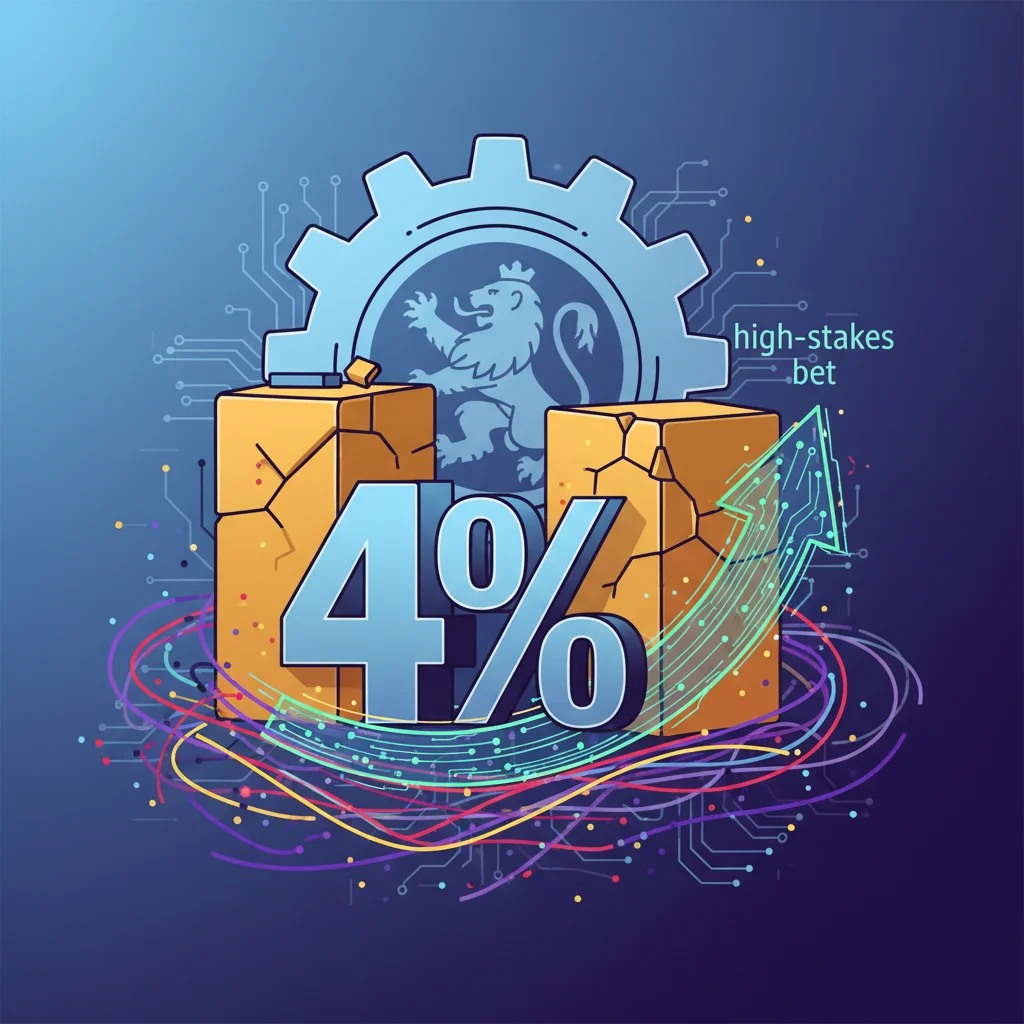
The 4% Standstill: Decoding the Bank of England’s High-Stakes Bet Against Inflation
In a move that resonated through the corridors of finance and across the global stock market, the Bank of England’s Monetary Policy Committee (MPC) has once again played its hand, holding the UK’s benchmark interest rate steady at 4%. This decision, while widely anticipated by economists and market analysts, marks a critical juncture in the nation’s fierce battle against an inflation rate that remains stubbornly persistent and significantly above the Bank’s 2% target.
This isn’t just a simple pause; it’s a calculated standstill on a high wire. On one side lies the chasm of runaway inflation, eroding purchasing power and destabilizing the economy. On the other, the risk of tipping a fragile economy into a deep recession. For investors, business leaders, and every household in the UK, understanding the nuances of this decision is paramount. It’s a signal that dictates the cost of borrowing, the returns on saving, and the overall sentiment driving the financial markets. In this deep dive, we’ll dissect the Bank’s strategy, explore its far-reaching consequences, and analyze what this means for the future of finance, investing, and the burgeoning world of financial technology.
The Anatomy of the Decision: A Hawkish Hold
To fully grasp the significance of holding rates at 4%, we must first understand the context. This decision did not occur in a vacuum. It follows one of the most aggressive series of rate hikes in the Bank’s recent history, a deliberate campaign to cool an overheating economy. The primary adversary remains the Consumer Prices Index (CPI), a measure of inflation which, at the time of such decisions, has hovered at levels not seen in decades. For perspective, with a target of 2%, an inflation rate lingering near double digits represents a severe economic challenge.
So, why press pause now? The MPC’s logic is multifaceted:
- The Lag Effect: Monetary policy operates with a significant time lag. The full impact of previous rate hikes is yet to filter through the economy, typically taking 12-18 months. The Committee is now in a “wait-and-see” mode, assessing whether the medicine administered so far is beginning to work.
- Signs of Cooling: While headline inflation remains high, there are tentative signs in underlying data that price pressures may be starting to ease. Energy prices have somewhat stabilized, and supply chain disruptions are lessening. Hiking rates further too quickly could slam the brakes on the economy too hard, causing unnecessary economic pain.
- Global Economic Headwinds: The UK economy is not an island. Slowdowns in major economies like the US and the Eurozone, coupled with geopolitical instability, create an uncertain global backdrop. The Bank must balance its domestic fight against inflation with the risk of being buffeted by external shocks.
This is what analysts often term a “hawkish hold.” The message is clear: “We are holding steady for now, but our finger remains on the trigger. If inflation does not continue its downward trajectory, we will not hesitate to act again.” This forward guidance is crucial for managing expectations in the financial markets, from currency trading desks to institutional investment firms.
The Ripple Effect: What a 4% Rate Means for the Economy
A benchmark interest rate is the central cog in the financial machine. Its setting sends ripples through every corner of the economy. Let’s break down the tangible impacts for different groups.
For Homeowners, Savers, and Consumers
For the average person, the Bank’s rate directly influences the cost of mortgages and the return on savings. Those on tracker or variable-rate mortgages have already seen their monthly payments surge. A sustained 4% rate means this financial pressure continues. Conversely, savers benefit from higher returns, though often these returns are still outpaced by the high rate of inflation, resulting in a negative real return on their capital.
For Businesses and Corporate Finance
Business leaders face a challenging environment. The cost of borrowing for expansion, investment in new technology, or managing cash flow remains elevated. This can stifle growth and innovation. Furthermore, as consumer budgets are squeezed by higher mortgage costs and general inflation, demand for goods and services may weaken, impacting corporate revenues and profitability. This dynamic is a key focus for stock market analysts when evaluating corporate earnings forecasts.
For Investors and the Stock Market
The world of investing is particularly sensitive to interest rate policy. Higher rates generally make lower-risk assets like government bonds more attractive relative to equities. They also increase the “discount rate” used to value future company earnings, which can put downward pressure on stock prices, especially for growth-oriented technology companies whose valuations are based on long-term profit potential.
The following table provides a snapshot of the broad impacts across key financial areas:
| Financial Area | Impact of Sustained 4% Rate | Key Consideration for Individuals/Investors |
|---|---|---|
| Mortgages | Variable and tracker rates remain high, increasing costs for millions of homeowners. Fixed-rate deals are priced higher than in previous years. | Homeowners should review their mortgage terms and consider locking in a fixed rate if they fear further hikes. |
| Savings Accounts | Returns on savings are the highest in over a decade, offering better yields for cash-rich individuals. | Compare savings rates across different banks, including digital and fintech providers, but weigh returns against the current inflation rate. |
| Business Loans | The cost of capital for businesses is elevated, potentially delaying investment and expansion plans. | Businesses must conduct rigorous cost-benefit analysis for new projects and optimize working capital management. |
| Stock Market | Higher borrowing costs can squeeze corporate profits. “Growth” stocks may underperform, while “value” stocks in sectors like banking could benefit. | Investors should focus on companies with strong balance sheets, pricing power, and resilient cash flows. Diversification remains key. |
| Government Bonds (Gilts) | Yields on UK government bonds remain relatively high, offering a more attractive return for risk-averse investors. | Bond prices have an inverse relationship with yields. The current environment may offer opportunities for fixed-income investors. |
The Role of Fintech and Modern Finance in a High-Rate World
This challenging economic landscape is also a catalyst for innovation, particularly within the financial technology sector. The era of near-zero interest rates is definitively over, and the fintech industry is adapting rapidly to provide new solutions for consumers and investors.
We are seeing a surge in innovation from digital banking platforms that are able to pass on higher savings rates to customers more quickly than traditional incumbents. Financial technology is also empowering investors with more sophisticated tools for risk management. AI-powered trading platforms can analyze market volatility and macroeconomic indicators in real-time, offering insights that were once the exclusive domain of institutional investors. Robo-advisors are recalibrating portfolios to account for the new economic reality, shifting allocations towards assets that perform better in an inflationary, high-rate environment.
The conversation around blockchain and decentralized finance (DeFi) also takes on a new dimension. Proponents argue that DeFi offers an alternative financial ecosystem, one that is not subject to the monetary policy decisions of a central banking authority. While the sector is still nascent and carries its own significant risks, the core concepts of decentralized lending, borrowing, and trading are gaining traction as individuals seek ways to hedge against the policies of traditional finance. The stability and utility of well-regulated stablecoins, for example, are being tested as a potential digital asset that can operate within this new paradigm.
The Billion-Pound Blunder: When Green Investments Create a Financial Nightmare
The Road Ahead: Navigating Economic Uncertainty
The Bank of England’s decision to hold rates at 4% is not an endpoint; it is a waypoint on a long and uncertain journey. The MPC will be watching a dashboard of critical economic indicators with hawk-like intensity before its next meeting. These include:
- Inflation Data (CPI & PPI): The headline number is key, but they will be digging deeper into core inflation (which strips out volatile food and energy) and services inflation, which is often linked to wage growth.
- Labor Market Statistics: Data on unemployment, wage growth, and job vacancies will be crucial. A tight labor market can fuel inflation, making it a primary concern for the Bank.
- GDP and Growth Figures: The Bank must ensure its policies are not causing an unnecessarily deep recession. Any signs of a sharp economic contraction could prompt a change in course.
The path forward is fraught with uncertainty. The global economics landscape, particularly the policy decisions of the US Federal Reserve and the European Central Bank, will continue to exert a powerful influence. If other central banks continue to hike aggressively, it could put downward pressure on the pound sterling, which in turn could import more inflation into the UK.
For everyone involved in the economy—from the finance professional managing a multi-billion-pound portfolio to the small business owner seeking a loan—this period demands vigilance, adaptability, and a deep understanding of the forces at play. The era of easy money is over, and the age of strategic capital allocation is here.
In conclusion, the Bank of England’s 4% standstill is a profound statement on the current state of the UK economy. It is a moment of cautious observation in a protracted war against inflation. The implications are vast, touching every aspect of personal and corporate finance, from mortgages to the stock market. As we move forward, the interplay between monetary policy, economic data, and technological innovation in fintech will shape the landscape for years to come. Success will be defined not by bold, aggressive moves, but by a steady hand and the wisdom to know when to act—and when to hold.


